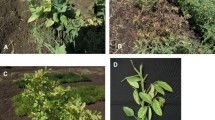Panicum streak virus (PanSV; genus Mastrevirus, family Geminiviridae) is, together with maize streak virus (MSV), sugarcane streak virus (SSV), sugarcane streak Reunion virus (SSRV) and sugarcane streak Egypt virus (SSEV), one of the currently described “African streak virus” (AfSV) species [6]. As with all the other AfSV species other than MSV, very little is known about PanSV genomic sequence diversity across Africa. Only two PanSV full genome sequences have ever been reported: one from Kenya [2], and the other from South Africa [17]. Both these genomes were isolated from Panicum maximum plants, but share only approximately 90% sequence identity. The reason this is noteworthy is that throughout mainland Africa all MSV genomes ever sampled from maize have been found to share >97% sequence identity. Although other MSV strains sharing between 78 and 90% identity with the maize-adapted strain (MSV-A) have been described, these have all been isolated from different host species, indicating that host adaptation is probably the main force driving MSV diversification. MSV and PanSV share common vector species (leafhoppers in the genus Cicadulina) and probably also share some host species. Although the host range of PanSV is currently unknown, the MSV host range is extensive and includes P. maximum [3]. One might therefore expect that similar evolutionary forces acting on both species might result in their sharing similar patterns of both geographical and host-associated diversity. Here we describe the full genome sequences of five new PanSV isolates (including two new strains) sampled from southern and western Africa, and report that PanSV and MSV do indeed have similar patterns of diversity. We find, however, that unlike with MSV, geographical separation rather than host adaptation is possibly the dominant force driving PanSV diversification.

Similar content being viewed by others
References
Boni M, Posada D, Feldman MW (2007) An exact nonparametric method for inferring mosaic structure in sequence triplets. Genetics 176:1035–1047
Briddon RW, Lunness P, Chamberlin LC, Pinner MS, Brundish H, Markham PG (1992) The nucleotide sequence of an infectious insect-transmissible clone of the geminivirus Panicum streak virus. J Gen Virol 73:1041–1047
Damsteegt VD (1983) Maize streak virus host range and vulnerability of maize germ plasm. Plant Disease 67:734–737
Gibbs MJ, Armstrong JS, Gibbs AJ (2000) Sister-scanning: a Monte Carlo procedure for assessing signals in recombinant sequences. Bioinformatics 16:573–582
Guindon S, Gascuel O (2003) A simple, fast, and accurate algorithm to estimate large phylogenies by maximum likelihood. Syst Biol 52:696–704
Hughes FL, Rybicki EP, von Wechmar MB (1992) Genome typing of southern African subgroup-1 geminiviruses. J Gen Virol 73:1031–1040
Martin D, Rybicki E (2000) RDP: detection of recombination amongst aligned sequences. Bioinformatics 16:562–563
Martin DP, Posada D, Crandall KA, Williamson C (2005) A modified bootscan algorithm for automated identification of recombinant sequences and recombination breakpoints. AIDS Res Hum Retroviruses 21:98–102
Martin DP, Williamson C, Posada D (2005) RDP2: recombination detection and analysis from sequence alignments. Bioinformatics 21:260–262
Martin DP, Willment JA, Billharz R, Velders R, Odhiambo B, Njuguna J, James D, Rybicki EP (2001) Sequence diversity and virulence in Zea mays of maize streak virus isolates. Virology 288:247–255
Maynard Smith J (1992) Analyzing the mosaic structure of genes. J Mol Evol 34:126–129
Owor BE, Martin DP, Shepherd DN, Edema R, Monjane AL, Rybicki EP, Thomson JA, Varsani A (2007) Genetic analysis of maize streak virus isolates from Uganda reveals widespread distribution of a recombinant variant. J Gen Virol 88:3154–3165
Owor BE, Shepherd DN, Taylor NJ, Edema R, Monjane AL, Thomson JA, Martin DP, Varsani A (2007) Successful application of FTA Classic Card technology and use of bacteriophage phi29 DNA polymerase for large-scale field sampling and cloning of complete maize streak virus genomes. J Virol Methods 140:100–105
Padidam M, Sawyer S, Fauquet CM (1999) Possible emergence of new geminiviruses by frequent recombination. Virology 265:218–225
Posada D (2006) ModelTest Server: a web-based tool for the statistical selection of models of nucleotide substitution online. Nucleic Acids Res 34:700–703
Posada D, Crandall KA (2002) The effect of recombination on the accuracy of phylogeny estimation. J Mol Evol 54:396–402
Schnippenkoetter WH, Martin DP, Hughes FL, Fyvie M, Willment JA, James D, von Wechmar MB, Rybicki EP (2001) The relative infectivities and genomic characterisation of three distinct mastreviruses from South Africa. Arch Virol 146:1075–1088
Tamura K, Dudley J, Nei M, Kumar S (2007) MEGA4: molecular evolutionary genetics analysis (MEGA) software version 4.0., pp 1596–1599
Thompson JD, Higgins DG, Gibson TJ (1994) CLUSTAL W: improving the sensitivity of progressive multiple sequence alignment through sequence weighting, position-specific gap penalties and weight matrix choice. Nucleic Acids Res 22:4673–4680
Acknowledgments
This research was partially funded by the National Research Foundation (South Africa). AV is supported by the Carnegie Corporation of New York. DNS is supported by PANNAR (Pty) Ltd; DPM is supported by the Harry Oppenheimer Trust and the Sydney Brenner Fellowship. PL is supported by the French Ministère de la Recherche et de l’Enseignement supérieur; BO is supported by the Rockefeller foundation through the USHEPiA programme; ALM is supported by the Canon Collins Trust for Southern Africa and a University of Cape Town International Scholarship.
Author information
Authors and Affiliations
Corresponding author
Electronic supplementary material
Below is the link to the electronic supplementary material.
Rights and permissions
About this article
Cite this article
Varsani, A., Oluwafemi, S., Windram, O.P. et al. Panicum streak virus diversity is similar to that observed for maize streak virus. Arch Virol 153, 601–604 (2008). https://doi.org/10.1007/s00705-007-0020-7
Received:
Accepted:
Published:
Issue Date:
DOI: https://doi.org/10.1007/s00705-007-0020-7




